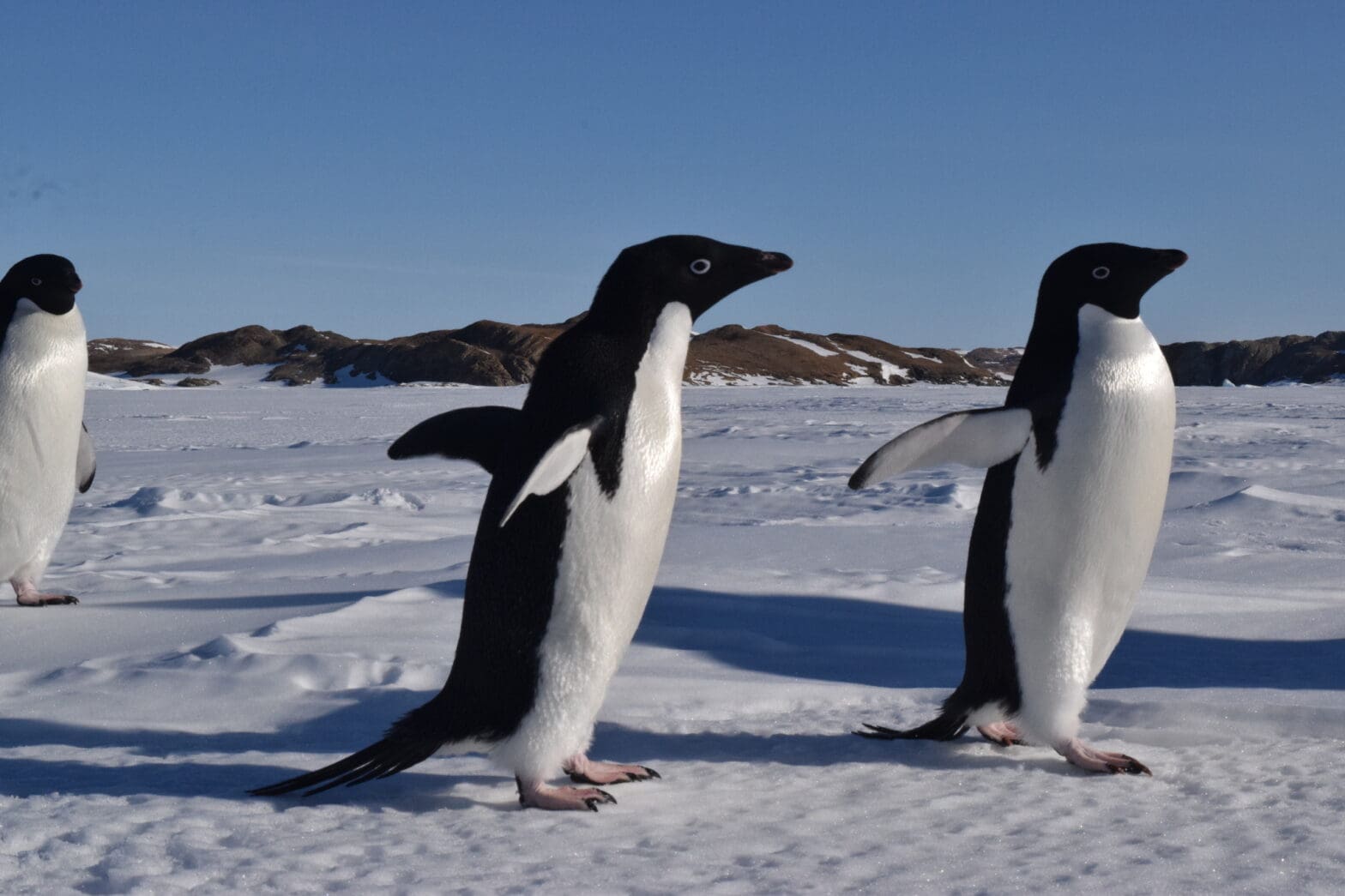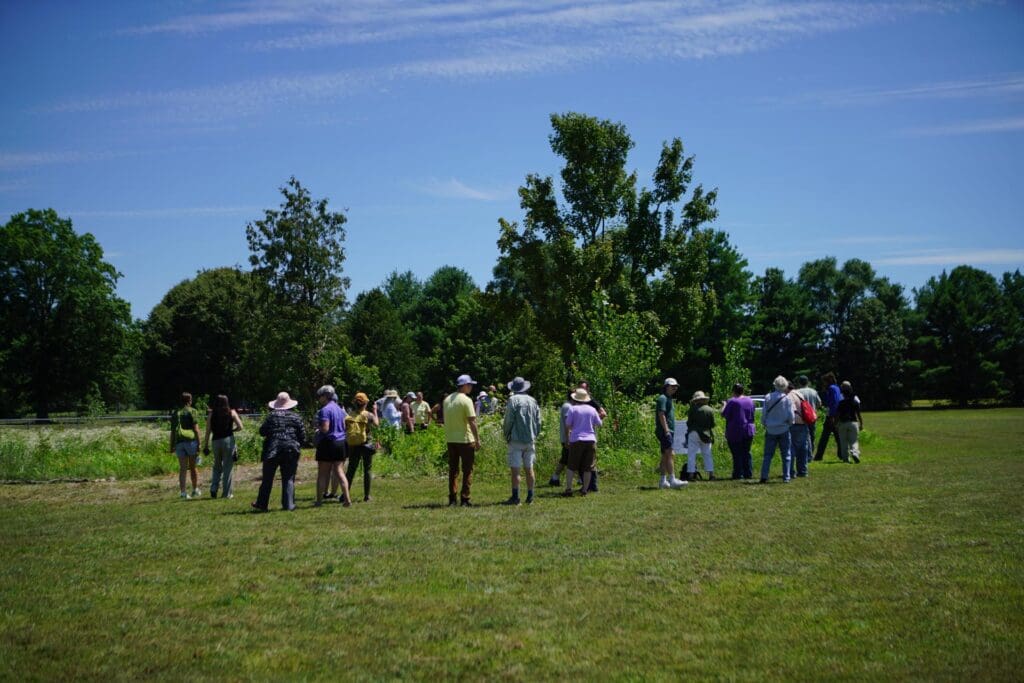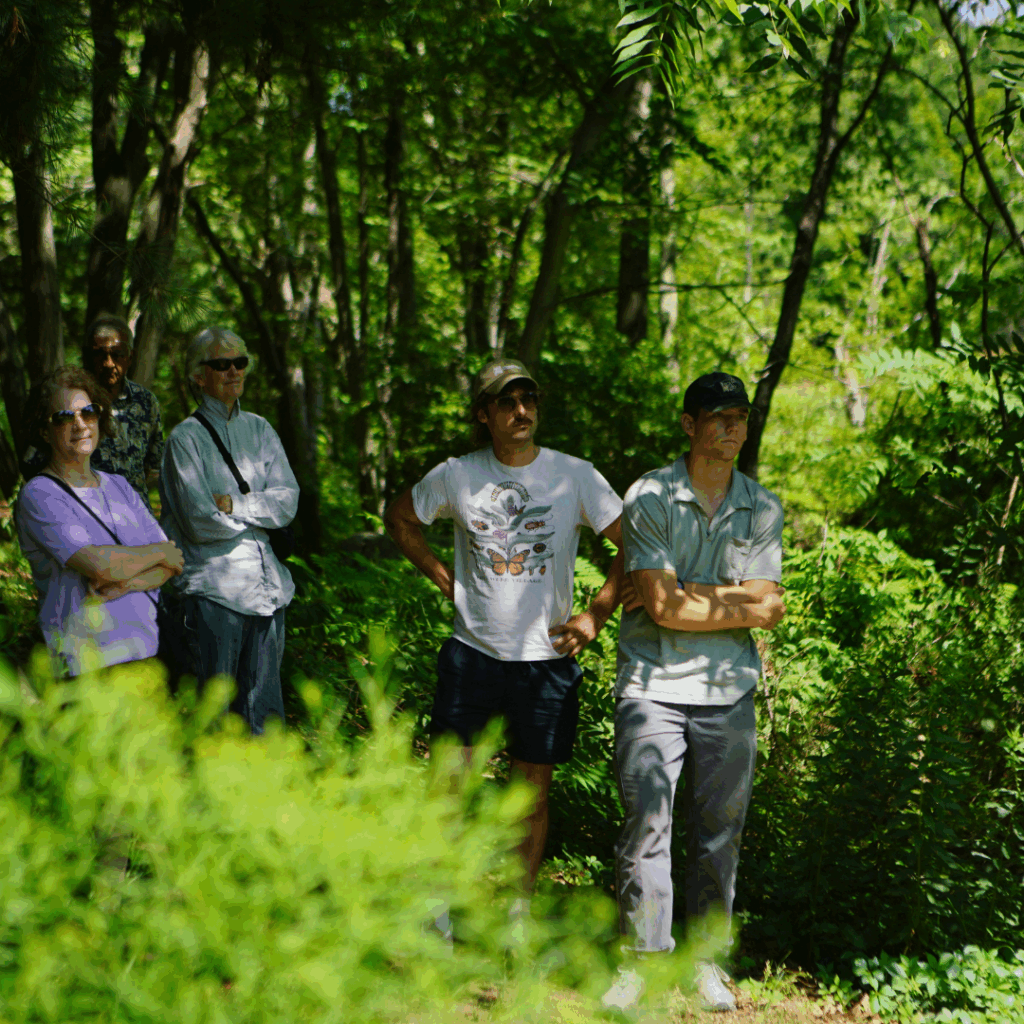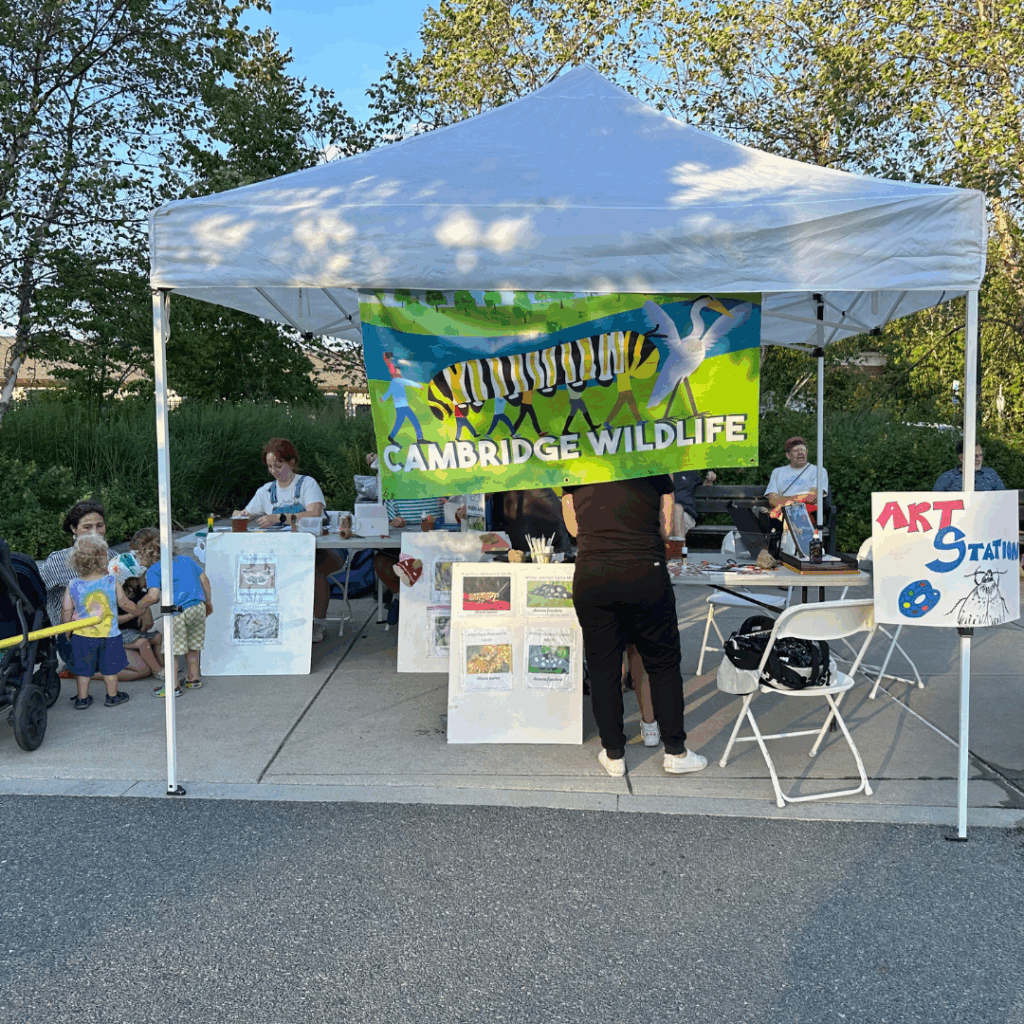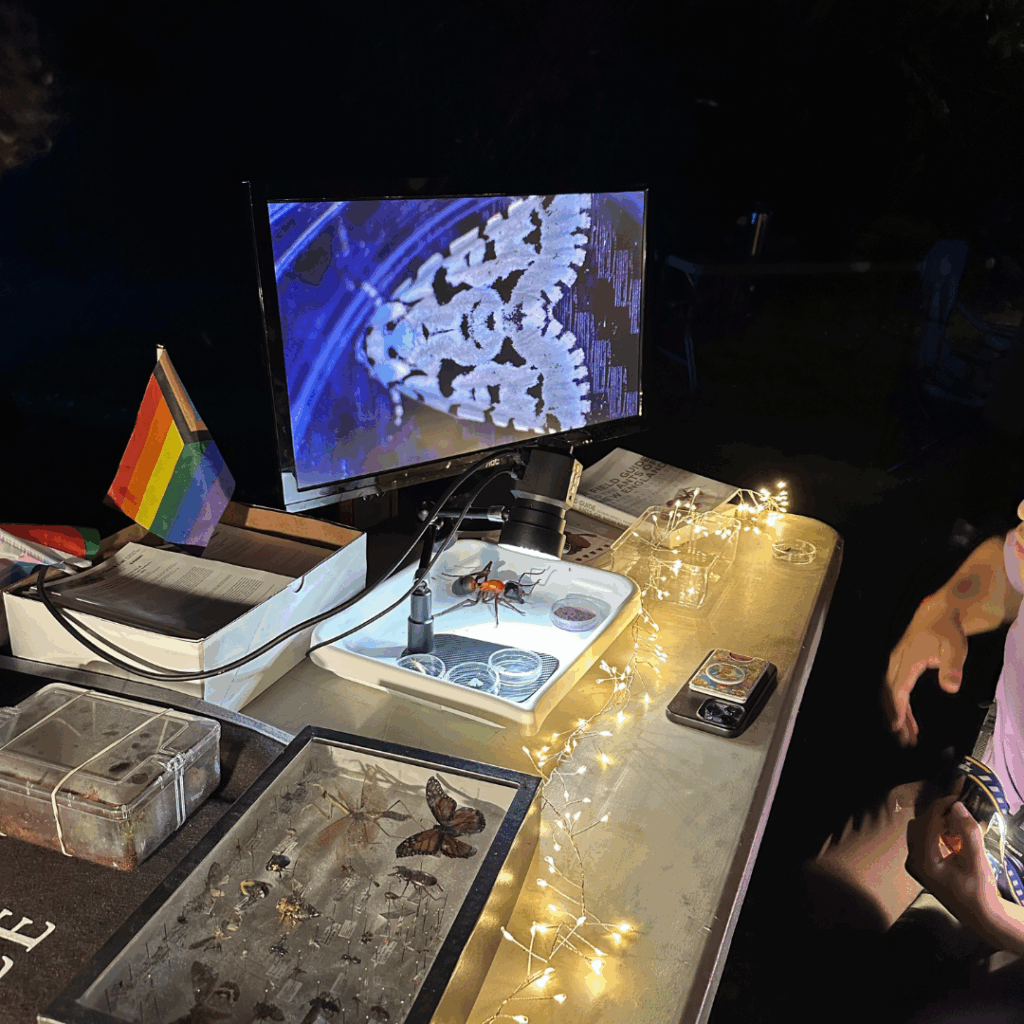What creature is able to control blood flow to their extremities, has eyes adapted for underwater vision, and spends 75% of its life at sea?
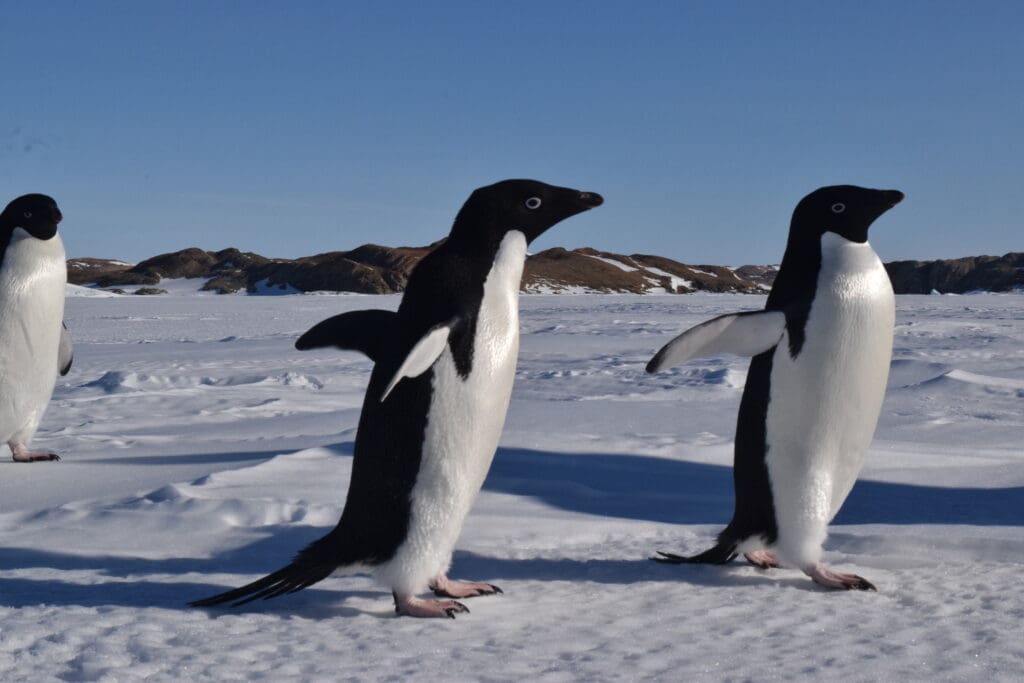
Image Credit: Nidhin Cyril Joseph via iNaturalist (CC-BY-NC)
Now that I’ve been writing for Biodiversity for a Livable Climate for a while, I’ve received several requests from friends and family for creatures to feature. This piece is the result of a request from my close friend’s two children, who, after listening to their parents read my feature on sloths, emphatically asked if I could write about penguins next.
Who am I to deny such an impassioned request?
While many penguins live in more temperate climates, today we’re putting the spotlight on the species that live in Antarctica and its surrounding islands.
When people share their ideas with me, it always gives me inspiration and prompts me to ask myself:
“What does this creature have to teach me about its life on Earth?” If you’re a penguin, the answer is, “quite a lot!”
Meet Our Flightless Friends
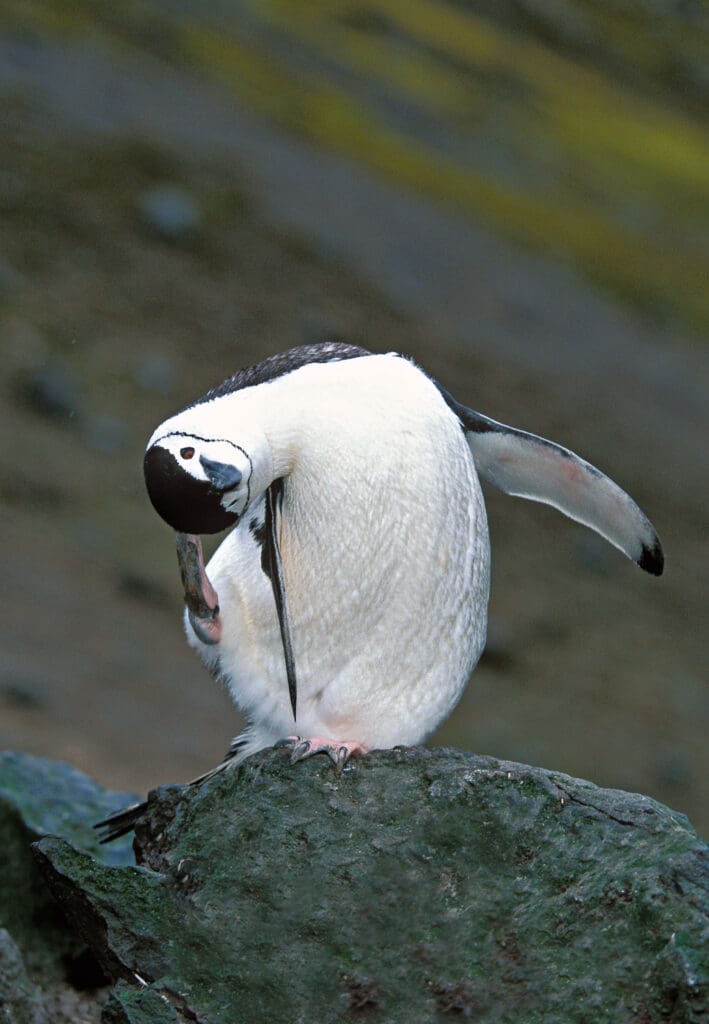
Image Credit: Greg Lasley via iNaturalist (CC-BY-NC)
If you play charades and act out the word “penguin,” you will probably start waddling, right? While the tendency to teeter back and forth on land is one of penguins’ most widely known (and adorable) characteristics, there is a lot more to them than that. Their countershaded plumage, flippers, and underwater vision are all features that make life as a penguin possible – and unique. But before we get to that, let me introduce you to our flightless friends.
Out of the 18 species of penguins, only eight of them live in the Antarctic. Out of those eight, only two species, Emperor and Adélie penguins, live exclusively on the ice shelves of the Antarctic continent. The rest of these cold climate birds – Macaroni, Gentoo, Chinstrap, Southern and Northern Rockhopper, and King penguins – live on the Antarctic Peninsula and surrounding sub-Antarctic islands.
In addition to their typical black and white feathers, many have distinctive features like red-orange beaks, or pale pink feet. Red eyes and yellow crests identify species like Macaroni penguins, and King and Emperor penguins can be recognized by the orange and yellow plumage on their chests and cheeks.
Here’s something you might not know: one in every 50,000 penguins are born with brown, cream-colored feathers rather than with black plumage. This washed-out look is called isabelline. While it’s not the same as albinism (which is defined by a complete lack of pigmentation) isabellinism is the partial loss of pigment.
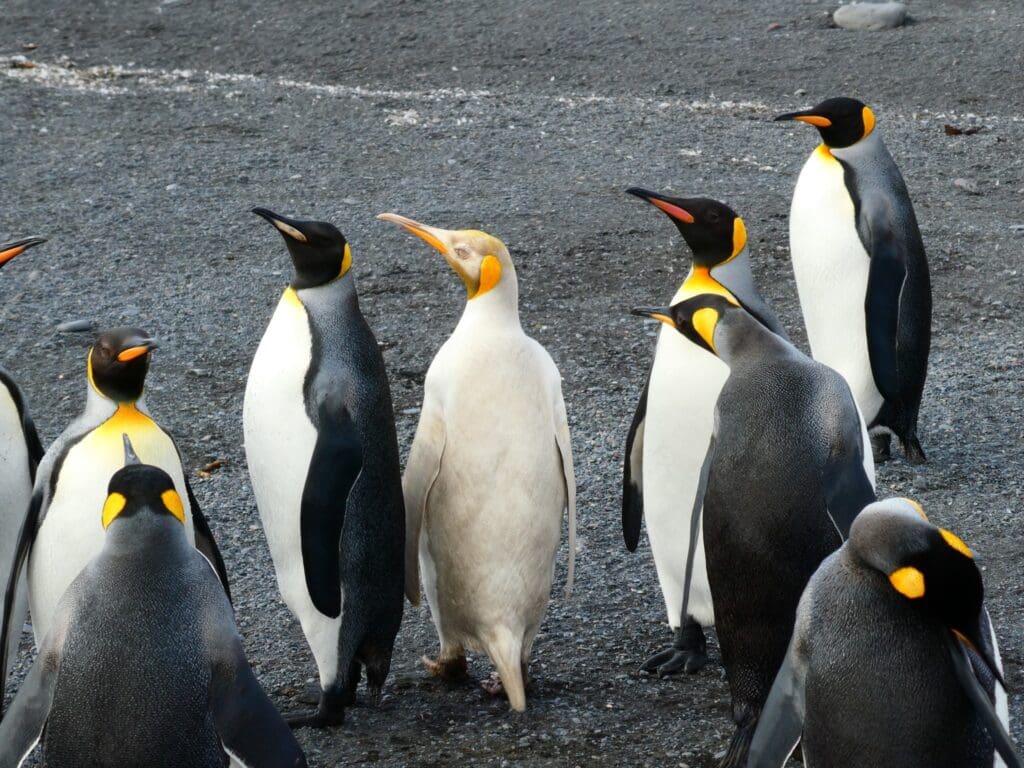
Image Credit: Sebastian Traclet via iNaturalist (CC-BY-NC)
The Birds that Swim
Penguins are highly specialized for life in ocean water, and have many adaptations that suit their lifestyle in their environment. These beautiful birds have streamlined bodies that are equipped with a well-developed rib cage, wings that have evolved into flippers with shorter and stouter bones, and a pronounced keel, or breastbone, which provides an anchor for the pectoral muscles that move the flippers. Penguins might not be able to fly in the air, but they propel themselves with incredible agility into “flight” underwater with their flippers. In the water, Gentoo penguins (pictured below) are the fastest of all penguins, and of all swimming birds. While searching for food or escaping predators, they reach speeds up to 36 km (22 miles) per hour.
Their eyes, which are their primary means of locating evasive prey and avoiding predators and fishing nets, are adapted for underwater vision. And these aren’t the only traits that make penguins incredibly well-fit for aquatic life. Their short feathers, which minimize friction and turbulence as they swim, are denser than most other birds, with up to 100 feathers per square inch in some species, such as the Emperor penguin. This close spacing helps keep penguins warm, preserving a layer of air under their plumage that not only insulates them from the cold water, but also provides them with buoyancy.
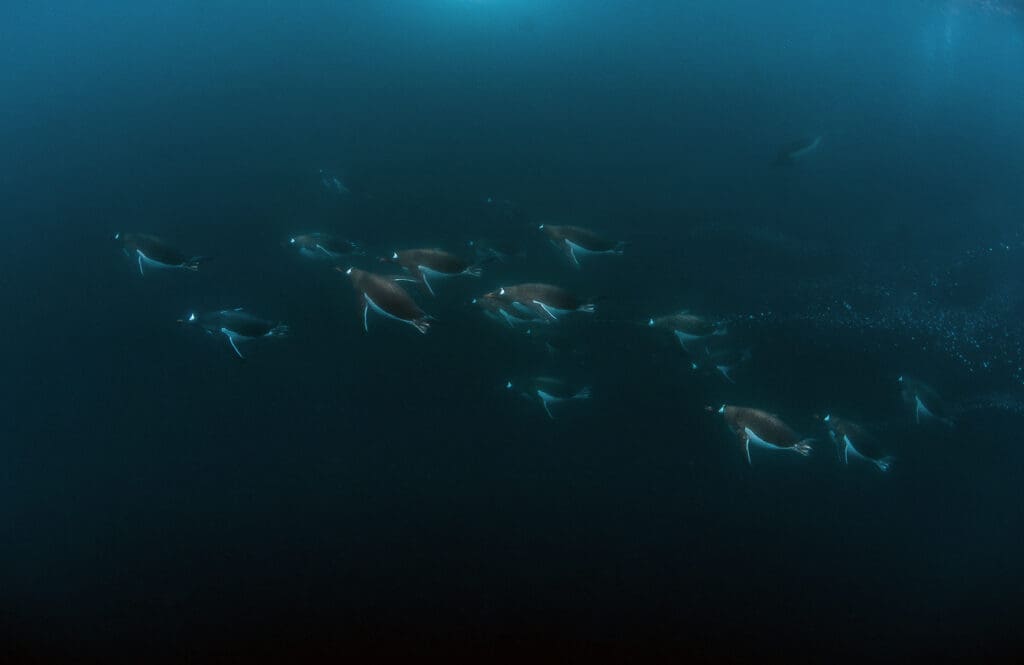
Image Credit: Laura Babahekian via iNaturalist (CC-BY-NC)
Penguins also conserve heat in other ways. They possess this remarkable vascular countercurrent heat exchanger called a humeral arterial plexus – a system of heat exchange between opposing flows of blood. This allows cold blood to absorb heat from outflowing blood that has already been warmed, limiting heat loss in their flippers and feet, ultimately helping these small animals survive in such cold.
What Else Do Penguins Have to Teach Us?
We already know that most penguins have darker feathers on their backs and wings, and lighter-colored feathers on their bellies, but why? Called countershading, it’s actually a form of camouflage. For predators like orcas, it is difficult to look up from below and distinguish the white belly of a penguin from the water’s surface and sky above it. Similarly, from above, the bird’s dark back blends into the darker ocean depths. It’s speculated that birds with extreme plumage irregularity, like isabelline penguins that don’t have the advantage of camouflage, have a decreased life expectancy as a result of increased predation. However, research shows that isabelline individuals have survived for many years.
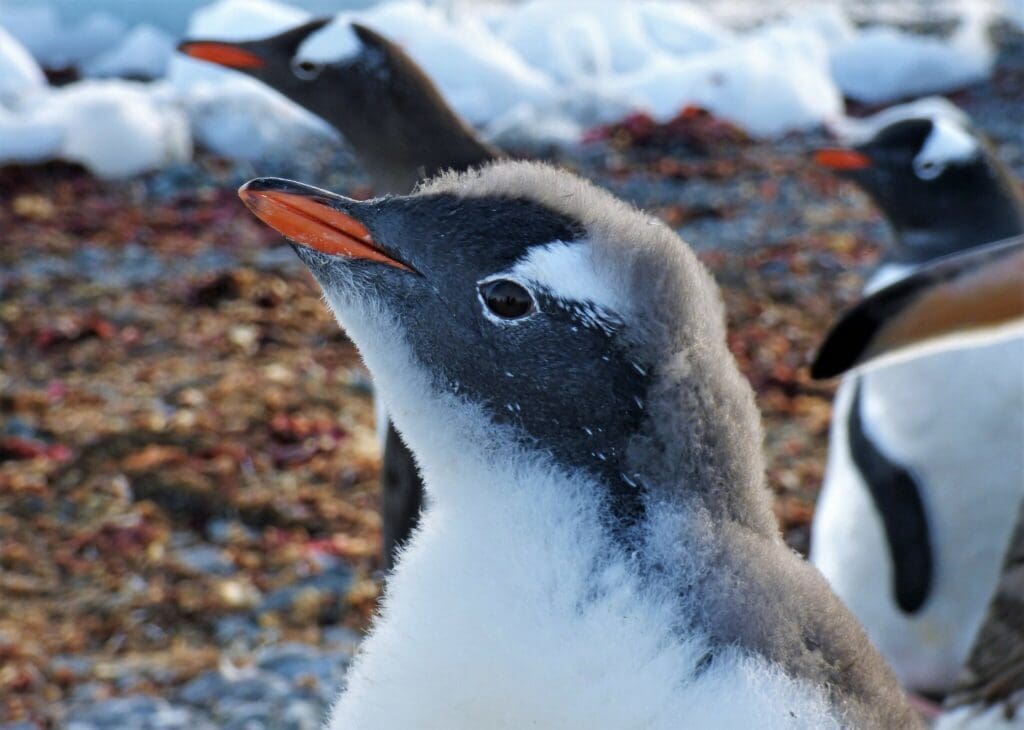
Image Credit: Hugo Hulsberg via iNaturalist (CC0)
While most penguins share incubation duties (one parent broods while the other forages at sea, switching when the other returns) species like the Emperor and King penguins have unique strategies where the males take on greater, or even sole, responsibility. But, the parents’ warm bodies are not the only thing protecting their babies: the eggs of cold-climate penguins are well-adapted to their adverse nesting environment too, with thick shells that reduce the chick’s dehydration and the risk of breakage. Once a clutch hatches and the parents go out to hunt, on their way back to their colony, some penguins use the sun as a directional aid while others rely on landmarks or even the Earth’s magnetic field to navigate, like a built-in gps. Once safely on land, parents use unique vocal calls to locate and reunite with their baby.
Did you know that even though a group of penguins is called a colony, they can also be called a “waddle” on land, and a “raft” in the water? Still, penguins don’t waddle all the time. Besides their awkward and amusing side to side rock, penguins also jump with both feet together to move more quickly across steep or rocky terrain. Can you guess what the Southern and Northern Rockhopper penguins were named for? If penguins want to conserve energy while moving quickly, they’ll do something called tobogganing, sliding on their bellies across the snow while using their feet to propel and steer themselves.
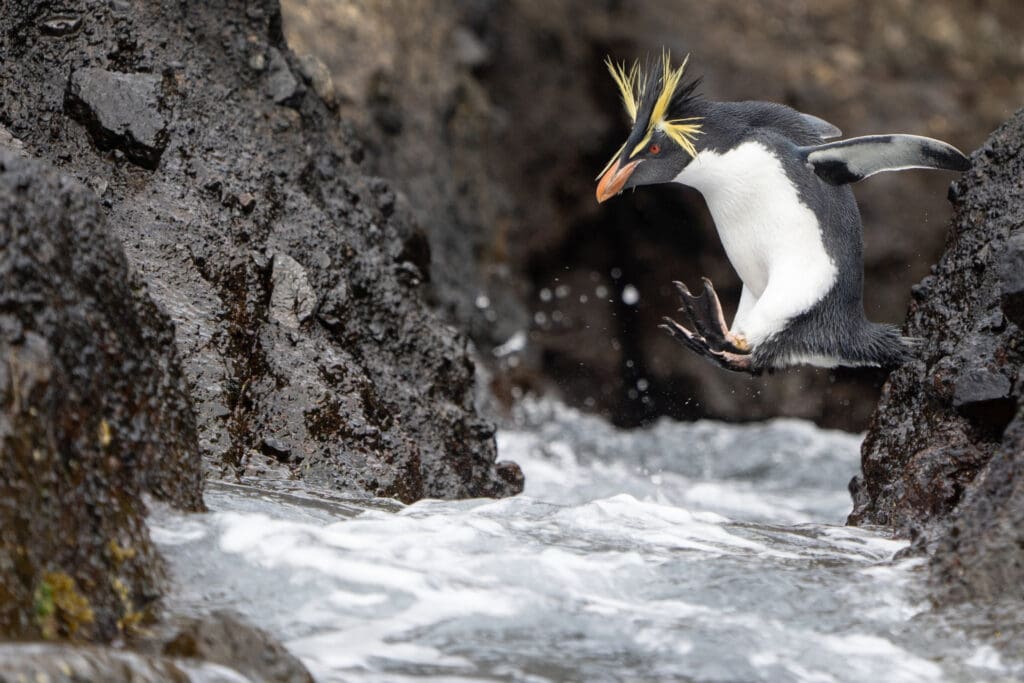
Image Credit: whale_nerd via iNaturalist (CC-BY-NC)
What is the Penguin’s Role in its Ecosystem?
Regardless of which ecosystem a creature calls home, Earth’s organisms always have a more significant role in their environment than we first realize. Penguins are an important part of land and ocean ecosystems. Adult penguins are prey for sharks, orcas, and leopard seals, and penguin eggs/chicks serve to sustain other land predators like pumas, mongooses, and many seabirds like skuas, petrels, and sheathbills. Our aquatic fliers use their powerful jaws and spiny tongues to grip their quarry, eating krill, small fish, crabs, and squid, and getting nutrients from the rich, well-oxygenated waters of their ecosystem. Penguins then in turn fertilize the landscape with the nutrients like nitrogen, phosphorus, and organic carbon from their ocean foraging.
Penguins also play a key role in their colony’s survival. They are incredibly social creatures, and as a result of the extreme Antarctic conditions they live in, huddle together to stay warm during violent winter storms, even rotating so each penguin gets a turn at the center of the heat pack. Many penguin species form long-term pair bonds, fostering better collaboration, sharing of responsibilities, and improving the success of breeding over time. But, some have high divorce rates, switching mates in different breeding seasons.
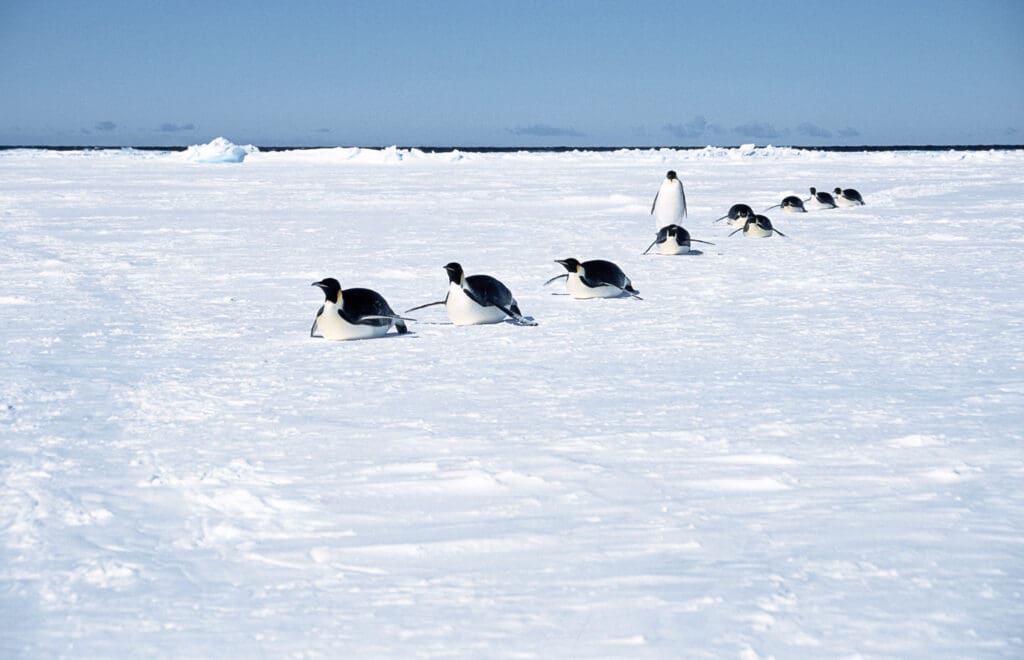
Image Credit: Greg Lasley via iNaturalist (CC-BY-NC)
Threats
Most penguin specie populations are declining, with nine out of the 18 species classified as endangered or vulnerable on the IUCN Red List.
While the Antarctic Treaty has provided some legal protections for penguins, these birds are still at risk. You might have already guessed one of the reasons why: climate change. The rapid increase in temperature around the globe is altering oceanic conditions and melting sea ice, threatening penguins’ food supply, breeding grounds, and the delicate natural infrastructure of water and ice that sustains their way of life. In fact, we’ve recorded a correlation between record low sea ice in 2022 and the first-ever known large-scale breeding failure of Emperor penguins, an episode in which few (or nearly none at all) chicks are born.
Penguins are also at risk from pollution, caused by the usual suspects: littering and ecological disasters like oil spills. Development projects threaten nesting sites, and unsustainable and irresponsible fishing practices increase competition for available food in the sea.
And just last year, H5N1, so-called “bird flu,” was detected in the Antarctic region. Due to their dense breeding practice, the looming threat to penguin colonies is significant if the virus continues to spread around the region and continent.
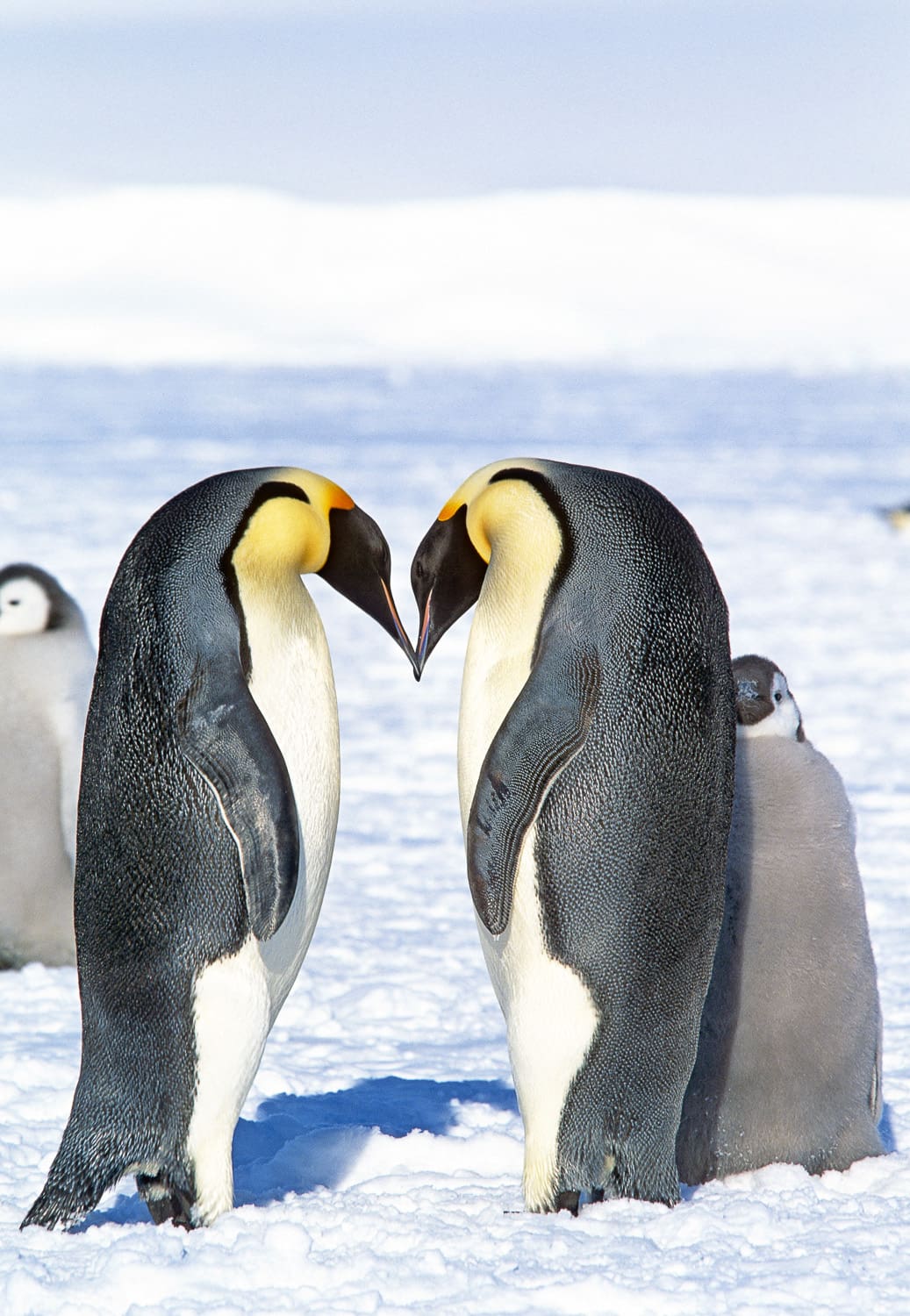
Image Credit: Greg Lasley via iNaturalist (CC-BY-NC)
Life on Earth
Some of these risks are more dangerous or difficult to combat than others, but doing our part to help protect penguins is not a hopeless cause. We can support marine protected areas that provide refuge for vulnerable species like penguins and conservation organizations that focus on preserving penguin populations and their habitats. We can spread awareness about the threats they face, advocate for the nature-based solutions that keep the Antarctic cool, and do our part to keep our oceans clean.
I’ve come to understand that these penguins that dwell in some of the coldest places on Earth are some of most resilient animal species on Earth. Despite the challenges their environment throws at them, they are strong and patient, and work together to survive and thrive.
Now, join me if you will in taking a deep, collective breath before I present this to some tough critics, my friend’s children. 🙂

Abigail Gipson is an environmental advocate with a bachelor’s degree in humanitarian studies from Fordham University. Working to protect the natural world and its inhabitants, Abigail is specifically interested in environmental protection, ecosystem-based adaptation, and the intersection of climate change with human rights and animal welfare. She loves autumn, reading, and gardening.
Sources and Further Reading
- Penguins (Family Spheniscidae) · iNaturalist
- Penguin Facts: Diet, Behavior, Habitat & Conservation | IFAW
- Penguins Facts and Information | United Parks & Resorts
- Penguin | Habitat, Species, Predators, & Facts | Britannica
- Penguin | Species | WWF
- World Penguin Day 2024: 6 Facts About Endangered Penguin Species | Earth.Org
- Record low 2022 Antarctic sea ice led to catastrophic breeding failure of emperor penguins | Communications Earth & Environment
- Sub-Antarctic and Antarctic Highly Pathogenic Avian Influenza H5N1 Monitoring Project | SCAR First penguins die in sub-Antarctic of deadly H5N1 bird flu strain | Antarctica | The Guardian

